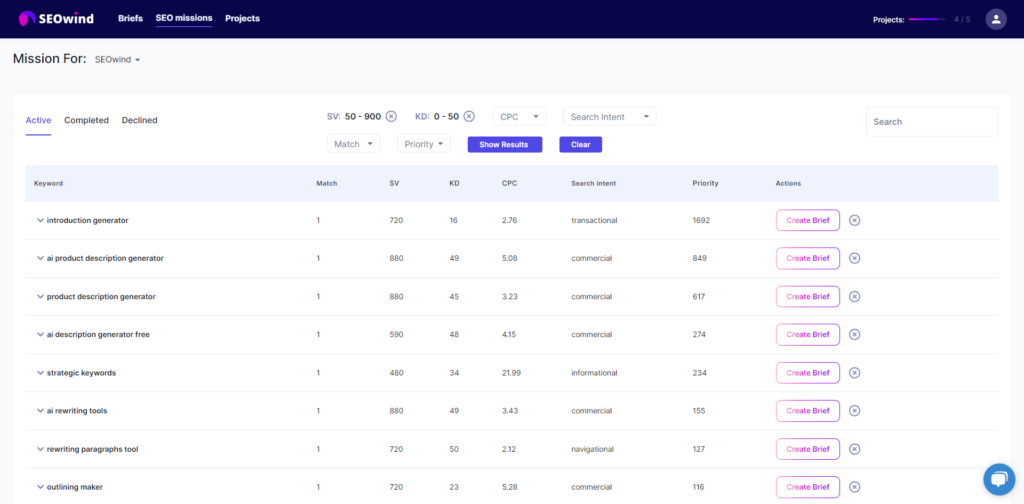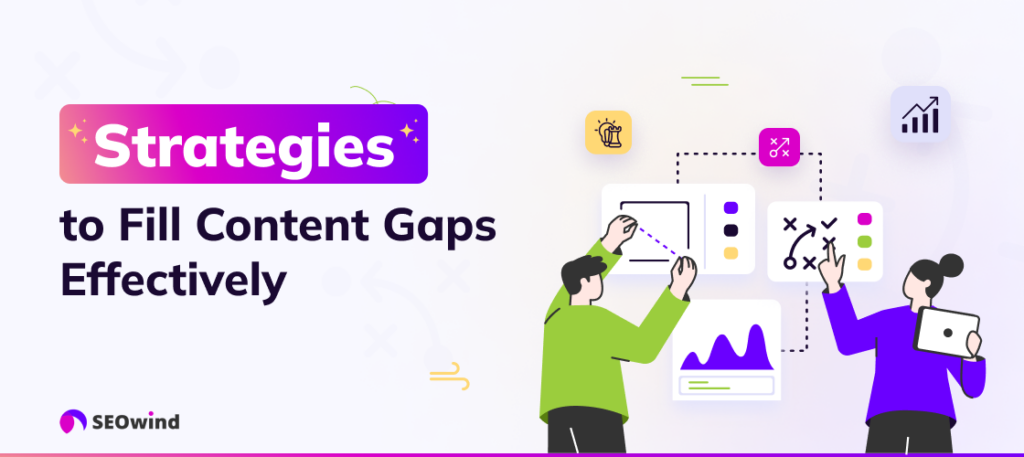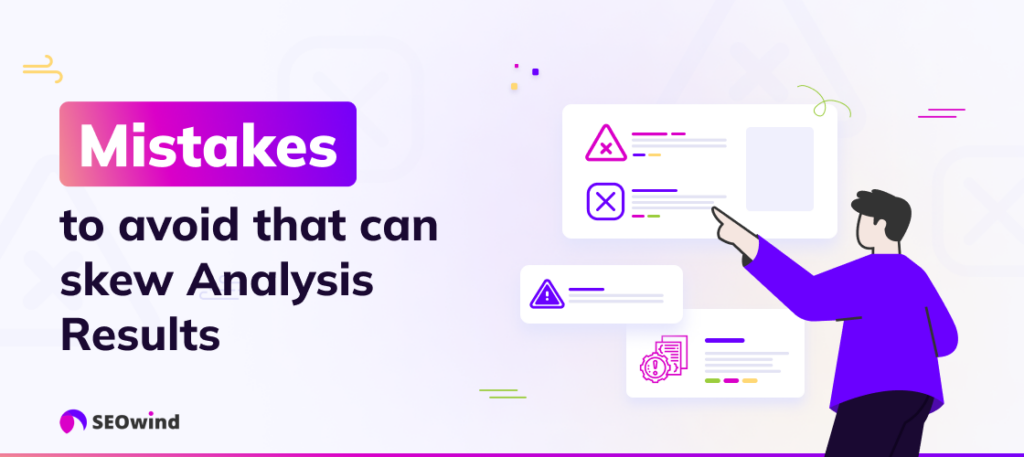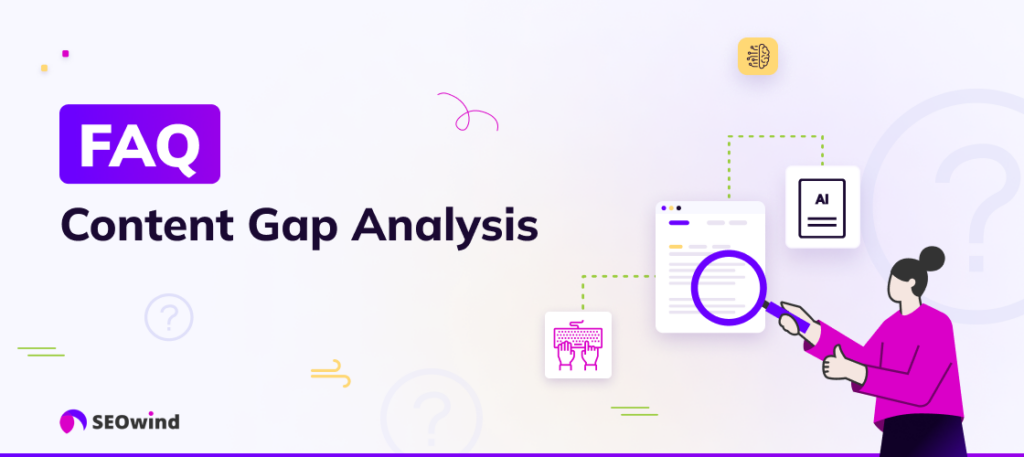Have you ever poured your heart and soul into creating content you thought was amazing, only to hear crickets chirping when you hit publish? If so, you’re not alone. Many content creators struggle with getting their work seen by the right audience. But what if I told you there’s a new approach that can transform your content strategy and catapult your SEO to new heights?
That secret weapon is content gap analysis. By uncovering where your competitors are falling short, you can create content that truly resonates with your target market and fills a void in the online landscape.
So, are you ready to unlock the power of content gap analysis and watch your SEO excel? Let’s dive in!
What is a content gap analysis?

Imagine you’re building a bridge. You wouldn’t just start laying bricks without a plan, right? Instead, you need to assess the landscape, identify the gap you want to address, and choose the correct materials and methods to complete the project. Content gap analysis works similarly.
It’s a strategic process that involves identifying the elements missing from your existing content, the topics your audience wants to learn about but can’t find answers to, and the areas where your competitors outperform you. This approach focuses on pinpointing the gaps in your content strategy and developing a plan to fill them with high-quality, targeted content.
Identifying Types of Content Gaps

Now that we’ve established content gap analysis as a strategy, what information are we looking for? Let’s cover the different content gaps you might encounter on your journey.
Keyword Gaps: Unexplored Opportunities
Keyword gaps are the keywords and search terms that your target audience is using but that you’re not currently ranking for. Imagine all those people searching for information that you could be providing! Identifying these gaps can help you create content that directly addresses what your audience is interested in, driving more organic traffic and leads.
Topic Gaps: Broadening Your Subject Matter
Topic gaps go beyond specific keywords and cover broader subject areas. Maybe you’ve covered the basics of a topic, but there are related subtopics or niche areas that you haven’t explored yet. Addressing these topic gaps allows you to establish yourself as a more comprehensive and authoritative resource in your field.
Media Gaps: Diversifying Content Formats
Not everyone consumes content in the same way. Some prefer reading in-depth articles, while others gravitate to videos or infographics. Media gaps refer to a lack of variety in the formats of your content. By diversifying your content formats, you can cater to different learning styles and preferences, expanding your reach and engagement.
Buyer Journey Gaps: Ensuring a Seamless Experience
The buyer’s journey is the path a person takes from awareness of a problem to becoming a customer. Each stage of this journey requires different types of content. Buyer journey gaps occur when content that addresses specific stages is missing, leaving potential customers without the information they need to move forward.
Competitor-based, Topic-based, and Buyer-based Gap Analyses Explained
Now, let’s talk about the different approaches to finding these gaps:
- Competitor-based gap analysis: Analyze your competitors’ content to identify keywords, topics, and media formats they’re using successfully that you’re not. It’s like peeking at your neighbor’s garden to see what’s growing well and what you might be missing.
- Topic-based gap analysis: Here, the focus is on exploring a specific topic in detail and identifying any subtopics or related areas that your website hasn’t adequately covered.
- Buyer-based gap analysis: This approach centers on understanding your target audience and their needs at each stage of the buyer’s journey. It’s about mapping out the information they want and ensuring you have content that addresses those needs.
Each of these approaches offers valuable insights, and often, the most effective content gap analysis involves a combination of all three.
Why You Can’t Afford to Overlook Content Gap Analysis

Content gap analysis is not just some fancy term thrown around by SEO gurus but a crucial element for your online success. I’m not exaggerating when I say that neglecting this process can lead to some serious missed opportunities and hinder your growth in the long run.
Strengthening SEO and Organic Reach
By identifying hidden keyword opportunities and topics your audience is actively searching for, you’re filling in the missing pieces of your content puzzle, making your website more relevant and visible to search engines. This translates into higher rankings, increased organic traffic, and, ultimately, more eye on your brand.
Content gap analysis is crucial for building long-term success online. If neglected, it can lead to serious shortcomings over time. Remember, SEO is a long-term game, and content gap analysis is one of your most powerful tools to ensure sustainable growth and visibility.
Fulfilling Audience Needs More Completely
Imagine you’re at a restaurant, and while the appetizer and main course were delicious, you’re left craving something sweet. The restaurant, however, doesn’t offer any desserts. That’s what it feels like for your audience when you have content gaps. Content gap analysis helps you identify those missing pieces that complete the meal, so to speak. By understanding your target audience’s questions, concerns, and interests at each stage of their journey, you can create content that truly resonates with them. This leads to a more satisfying experience for your audience, which builds trust and loyalty.
Enhancing Brand Authority and Thought Leadership
When you consistently provide valuable, informative, and comprehensive content that addresses your audience’s needs, you position yourself as an expert in your field. Content gap analysis helps you identify opportunities to create content that showcases a deep understanding of your industry and a commitment to providing insightful and helpful information. This, in turn, enhances your brand’s authority and establishes your brand as a thought leader. People start to see you as a go-to resource, someone they can trust and rely on for accurate information and guidance. The more you demonstrate your expertise, the stronger your brand reputation becomes, leading to increased credibility and influence within your industry.
9 Methods for Finding Content Gaps

Alright, so we’ve established what content gap analysis is and why it’s important. Now, let’s roll up our sleeves and get to the exciting part: how to find content gaps. You can use various methods, each with its strengths and suitability depending on your specific needs and resources.
- Run a Content Gap Analysis Using an SEO Tool Like SEOwind
Tools like SEOwind can analyze your website, compare it to your competitors, and reveal the keywords they’re ranking for that you’re not. This can be a goldmine of information, highlighting potential gaps in your content strategy.
Think of it as a treasure map leading you to hidden keyword opportunities you might have otherwise missed. While some SEO tools require a subscription, their insights can be invaluable in guiding your content creation efforts.

- Audit Your Customer Journey and Identify Content Missing from the Funnel
Every customer experiences a journey with your brand, from awareness to consideration and finally to the decision stage. Auditing your customer journey involves mapping out each stage and identifying the content you have (or don’t have) to support and guide potential customers at every step.
For instance, are you missing blog posts that answer potential customers’ common questions or case studies that showcase your successes and build trust? Identifying these gaps can help you create content that nurtures leads and drives conversions.
- Manually Search Competitor Websites to Identify Content Gaps
Sometimes, the best way to find gaps is to see what your competitors are doing. Take some time to explore their websites and analyze the type of content they offer. They might have a comprehensive blog covering topics you haven’t touched on or offer downloadable resources like ebooks or white papers that you could also provide.
Remember, this isn’t about copying your competitors but understanding what works in your industry and identifying potential areas where you can differentiate yourself.
Google Search Console is a free tool that provides valuable insights into your website’s performance in Google Search. One of its many features is the ability to see the search queries that drive traffic to your site. Analyzing these queries can reveal topics or keywords you may not adequately address in your existing content.
For example, if you notice a significant number of searches for “how to identify content gaps,” it might indicate that you need to create a comprehensive guide on that topic.
- Perform a Self Content Audit
Taking a step back and evaluating your existing content is crucial for identifying strengths, weaknesses, and gaps. A content audit involves reviewing your digital material and assessing its relevance, accuracy, and effectiveness.
- Are there outdated blog posts that need refreshing?
- Are there topics you’ve covered superficially that could benefit from a more in-depth approach?
A self-content audit helps ensure you’re making the most of your existing assets and identifying areas for improvement.
- Uncover Untapped Keyword Opportunities
Keyword research is the cornerstone of SEO and is crucial in content gap analysis. It’s not just about finding the most popular keywords. You need to identify relevant keywords with a decent search volume that your competitors have overlooked. Tools like Semrush and Ahrefs can help you discover these untapped keywords, especially long-tail versions that target specific user intent. While your competitors are battling it out for the main keywords, you can cleverly target these niche terms and phrases to attract a more targeted audience.
- Find Competitors’ Featured Snippets
Have you ever noticed those informative boxes that appear at the top of Google search results? Those are featured snippets, and they are prime real estate for boosting your visibility. By identifying which keywords your competitors rank for in featured snippets, you can create content that steals the spotlight. Analyze the content format and style of those snippets and craft your own content that provides a more comprehensive and engaging answer to the user’s query.
- Find Striking-Distance Keywords
Striking-distance keywords are those for which your website already ranks on the second or third page of search results. With a little effort, you can push these keywords to the first page and significantly increase your organic traffic. Analyze the content that currently ranks for these keywords and identify areas where you can improve. Perhaps your content needs to be more in-depth, or maybe it lacks the visual appeal of your competitors. By addressing these gaps, you can give your content the boost it needs to reach the top.
- Discover Subtopics Worth Covering
When researching your primary keywords, don’t forget to explore related subtopics that can provide valuable insights into the specific needs and interests of your target audience. For example, if you’re writing about “content marketing,” subtopics could include “content creation tools,” “content distribution strategies,” or “measuring content marketing ROI.” By covering these subtopics, you demonstrate your expertise and provide a more comprehensive resource for your readers.
The Ultimate Guide to Conducting a Detailed Content Gap Analysis

Let’s go step by step through content gap analysis.
Map Your Content to the Buyer’s Journey
The first step in our content gap analysis adventure is understanding your audience’s journey. Think of it like planning a road trip. You need to know where you’re starting, where you’re going, and all the stops along the way. Similarly, mapping your content to the buyer’s journey involves identifying the different stages your potential customers go through, from awareness and consideration to decision and advocacy.
Ask yourself if you have content that caters to each of these stages. Are there gaps where your audience might feel lost or unsure? For example, if you have plenty of content aimed at the decision stage but lack resources for those just becoming aware of their needs, you’ll want to address that gap.
Conduct Comprehensive Market Research
Now that we have our map, it’s time to gather intel! Conducting thorough market research helps you understand the broader landscape of your industry and identify potential content gaps. This includes:
- Analyzing industry reports and trends: What are the hot topics and emerging themes in your field? Are there any areas where you can provide unique insights or perspectives?
- Monitoring social media conversations: What are people talking about online? What questions are they asking, and what challenges are they facing?
- Engaging with your audience directly: Conduct surveys, interviews, or focus groups to gain firsthand insights into their needs and preferences.
Remember, the more you know about your market, the better equipped you’ll be to create content that resonates with your audience and fills those crucial gaps.
Leverage SEO Tools for Deeper Insights
SEO tools provide invaluable data and insights to help us uncover hidden opportunities and refine our content strategy. Here are a few potent solutions to consider:
- Semrush: This comprehensive SEO platform offers a range of features, including keyword research, competitor analysis, and content gap identification.
- Ahrefs: Another popular SEO toolset, Ahrefs excels at backlink analysis, keyword research, and competitor research. It allows you to identify content gaps and opportunities for improvement.
- Google Search Console: This free tool from Google provides valuable data about your website’s performance in search results, including the keywords people use to find your site and the pages that rank well.
By leveraging these tools, you can gain a deeper understanding of your website’s strengths and weaknesses, identify content gaps, and track your progress over time.
Audit Internal Content Versus Competitors’ Offerings
Finally, it’s time to take a closer look at your content inventory and compare it to what your competitors are doing. This involves thoroughly auditing your existing content to identify areas for improvement and potential gaps. Consider the following:
- Content quality and relevance: Is your content up-to-date, accurate, and engaging? Does it address the needs and interests of your target audience?
- Content formats: Are you using various content formats, such as blog posts, articles, videos, infographics, and case studies?
- Content depth and comprehensiveness: Are you covering topics in sufficient detail? Are there any areas where you can provide more in-depth information or insights?
By comparing your content to that of your competitors, you can identify areas where you may be falling short and discover new content ideas to fill those gaps. Remember, the goal is not to copy what others are doing but to learn from their successes and create even better content that sets you apart.
Innovative Strategies to Fill Content Gaps Effectively

Once you’ve identified your content gaps, what’s next? At this point, it’s time to bridge those gaps and build a content strategy that resonates with your audience and elevates your SEO performance. Remember, we’re not just looking to create content. We want to develop strategic material that fills specific needs and establishes your brand as a thought leader in your industry. Let’s explore some powerful tactics to achieve that!
Creating Powerful Content Clusters for Enhanced Topic Authority
Think of content clusters as themed neighborhoods within your website, where each piece of content is a house contributing to the overall community vibe, which, in this case, is your topical authority. By creating a content cluster around a specific topic, you’re signaling to search engines that you’re an expert in that area. This can significantly boost your search rankings for relevant keywords.
Here’s how to build an effective content cluster:
- Pillar Page: Start with a comprehensive pillar page that acts as the central hub for your chosen topic. This page should provide a broad overview of the subject and link to more specific pieces of content within the cluster.
- Cluster Content: Create individual blog posts, articles, or infographics that provide more detail on specific aspects of your chosen topic. Each piece should link back to the pillar page, creating a web of interconnected content.
For instance, if you’re a fitness brand, your pillar page might be titled “The Ultimate Guide to Building Muscle.” Your cluster content could include articles on specific exercises, nutrition tips, workout plans, and the science behind muscle growth. As you build out your cluster, you’ll notice your authority on the topic of muscle building growing, both in the eyes of search engines and your audience.
Developing a Robust Plan for Regular Content Updates and Optimizations
The digital landscape is constantly evolving, and so should your content. Regularly updating and optimizing your existing content is crucial for maintaining its relevance and visibility in search results. Think of it like tending a garden – you need to nurture your content to help it flourish.
Here are some key steps to include in your content update plan:
- Refresh outdated information: Ensure your facts, figures, and statistics are current. As industries evolve, so does the information surrounding them. Keeping your content up-to-date demonstrates your commitment to accuracy and reliability.
- Optimize for new keywords: Keyword trends change over time. By regularly researching and incorporating relevant keywords, you can ensure your content remains discoverable by your target audience.
- Improve internal linking: As you create new content, look for opportunities to link to and from existing pieces within your content clusters. This strengthens your website’s overall structure and helps search engines understand the relationships between your content.
- Enhance readability: Review your older content and make sure it’s still easy to read and understand. This might involve breaking up long paragraphs, adding visuals, or updating your formatting.
Remember, content optimization is an ongoing process. By dedicating time to regular updates, you’ll ensure your content remains fresh, engaging, and discoverable.
Integrating User Feedback and Analytics for Continuous Improvement
Your audience and their behavior are invaluable sources of information for refining your content strategy. By actively listening to user feedback and analyzing website analytics, you can gain deeper insights into what resonates with your audience and identify areas for improvement.
Here’s how to leverage user feedback and analytics:
- Conduct surveys and polls: Directly ask your audience about their content preferences, pain points, and areas where they’d like to see more information. This firsthand feedback can guide your content creation efforts in a meaningful direction.
- Monitor social media engagement: Pay attention to comments, shares, and discussions surrounding your content on social media platforms. This can reveal what topics generate the most interest and where you need to provide more context or clarity.
- Analyze website traffic patterns: Tools like Google Analytics provide a wealth of data on user behavior, such as which pages are most popular, how long users stay on your site, and where they’re coming from. Use this information to understand what’s working well and identify areas where you can improve user experience.
Integrating user feedback and analytics into your content strategy allows you to create a continuous improvement cycle, ensuring your content remains relevant, engaging, and aligned with your audience’s needs.
Measuring the Impact of Closing Content Gaps

Okay, so you’ve done the hard work, identified your content gaps, and filled them with high-quality content. Now, how do you know if it’s actually making a difference? That’s where measuring the impact comes in. We need to understand what’s working, what’s not, and how to keep improving our content strategies.
Key Metrics to Track Success Over Time
You wouldn’t take a road trip without a map or GPS, right? Measuring your progress is your roadmap to content success. Here are some key metrics to keep an eye on:
- Organic Traffic: This is a fundamental metric. Are you seeing an increase in visitors coming from search engines? If so, your content is likely attracting the right audience.
- Keyword Rankings: Are you climbing the search engine ladder for your target keywords? Improved rankings mean your content is becoming more relevant and visible to users searching for information related to your niche.
- Click-Through Rate (CTR): This tells you how often people who see your content in search results actually click on it. A higher CTR indicates that your content is engaging and effectively entices users to visit your site.
- Bounce Rate: This measures how quickly people leave your site after viewing just one page. A decreasing bounce rate suggests that your content is keeping visitors engaged and interested in exploring further.
- Time on Page: Are visitors sticking around to read your content? Longer time-on-page durations indicate that your content is informative and captivating, holding your audience’s attention.
- Conversion Rate: Ultimately, you want your content to drive action, whether that means signing up for a newsletter, downloading a resource, or making a purchase. Track your conversion rate to see how effectively your content is influencing user behavior.
These metrics provide valuable insights into the effectiveness of your content gap analysis and content strategy as a whole. Remember, it’s essential to track these metrics over time to identify trends and patterns.
Adjusting Strategies Based on Performance Data
Data is your friend, and the insights you glean from your metrics can guide you in refining your content strategy. Let’s say you notice that your organic traffic is increasing, but your conversion rate remains stagnant. This might indicate that while your content attracts visitors, it’s not effectively guiding them to take a desired action. In this case, you might consider incorporating stronger calls to action or optimizing your content for conversions.
On the other hand, if you observe a high bounce rate on certain pages, it could suggest that the content isn’t resonating with your audience or meeting their expectations. This might call for revisiting the content, ensuring it’s aligned with user intent, and enhancing its quality and relevance.
Remember, content gap analysis is an ongoing process, not a one-time fix. Continuously monitor your performance data, adapt your strategies as needed, and keep your content fresh and engaging to maintain a competitive edge in the ever-evolving digital landscape.
Best Practices and Pitfalls to Avoid in Content Gap Analysis
Prioritizing Gaps for Maximum SEO Impact
Not all content gaps are created equal. Some gaps represent golden opportunities to attract a flood of organic traffic, while others might only bring in a trickle. As a result, you want to focus your energy on the areas with the highest potential payoff.
Here’s how to prioritize like a pro:
- Search Volume and Keyword Difficulty: Keywords with high search volume and low competition are low-hanging fruit. These are topics people are actively searching for, but there’s not a lot of existing content to compete with. Targeting these topics can give you a quick SEO boost.
- Relevance to Your Target Audience: It’s tempting to chase after high-volume keywords, but if they’re not relevant to your target audience, they won’t bring you qualified leads or customers. Focus on gaps that align with your audience’s needs and interests.
- Alignment with Business Goals: Ultimately, your content should support your overall business objectives. Prioritize gaps that can help you achieve specific goals, such as increasing brand awareness, driving sales, or establishing thought leadership. For instance, if you’re launching a new product, prioritize content gaps related to that product’s features and benefits.
Creating High-Quality, Engaging Content That Meets User Needs
Identifying content gaps is only half the battle. The real magic happens when you create exceptional content that fills those gaps and resonates with your audience. Remember, Google loves content that provides value and keeps users engaged.
Here’s how to craft content that hits the mark:
- Understand User Intent: Why are people searching for this information? What problems are they trying to solve? Tailor your content to address their specific needs and provide actionable solutions.
- Focus on Quality over Quantity: It’s better to have a few pieces of outstanding content than a mountain of mediocre material. Invest time in research, writing, and editing to ensure your content is informative, well-structured, and error-free.
- Incorporate Storytelling and Examples: Dry, factual content can be a snooze fest. Engage your readers with compelling stories, real-life examples, and relatable anecdotes to make your content more memorable and enjoyable.
- Optimize for Readability: Use clear and concise language, break up your text with headings and subheadings, and incorporate visuals to enhance readability.
Incorporating Multimedia and Interactive Elements for Better Engagement
Static text alone might not be enough to capture your audience’s attention. Spice things up by incorporating multimedia and interactive elements to create a more immersive and engaging experience.
Here are some ideas to get you started:
- Images and Videos: Visuals are powerful tools for conveying information and evoking emotions. Use high-quality images, infographics, and videos to complement your written content.
- Interactive Quizzes and Polls: Encourage audience participation and gather valuable data with interactive quizzes and polls related to your content.
- Embedded Social Media Feeds: Showcase your social media presence and encourage social sharing by embedding relevant feeds within your content.
- Downloadable Resources: Offer valuable resources such as ebooks, templates, or checklists that users can download in exchange for their contact information.
Remember, content gap analysis is an ongoing process, not a one-time event. New gaps will emerge as you create new content and your audience evolves. By continuously monitoring your performance and adapting your strategies, you can ensure that your content remains relevant, engaging, and optimized for SEO success.
Avoiding Common Mistakes That Can Skew Analysis Results

Embarking on a content gap analysis journey is commendable; however, it’s crucial to navigate potential pitfalls. Avoid these common missteps to ensure your analysis remains accurate and insightful.
Overlooking Long-Tail Keywords and Search Intent
Imagine planning a road trip by solely focusing on major highways while neglecting the scenic byways. Similarly, fixating only on high-volume keywords during your content gap analysis could mean missing out on long-tail keywords and search intent. Let’s say you’re in the fitness industry. While targeting “weight loss” might seem logical, long-tail variations like “weight loss for busy moms” or “sustainable weight loss plans” could uncover unique opportunities and engage with more specific audiences.
Are users seeking information, comparing products, or ready to make a purchase? Aligning your content with their intent is critical to attracting the right audience.
Neglecting the Mobile Experience
Neglecting the mobile experience during your analysis means ignoring a significant portion of your audience. Ensure your website and content are optimized for mobile devices. Google prioritizes mobile-friendliness in its search rankings, so a seamless mobile experience is a necessity.
Focusing Solely on Competitor Analysis
While competitor analysis is valuable, solely relying on it can lead you astray. Instead, broaden your perspective to encompass your target audience’s needs and the overall market landscape. Conduct thorough keyword research, analyze industry trends, and gather customer feedback to understand content gaps better.
Frequently Asked Questions About Content Gap Analysis

Taking the time to understand content gaps can initially feel overwhelming. But you’re not alone in this journey! Let’s address some common questions that arise when reviewing this topic.
How often should I perform a content gap analysis?
The ideal frequency of content gap analysis depends on several factors, including your industry’s dynamism, the competitiveness of your niche, and the pace of your content production. As a general guideline, consider conducting a thorough analysis every quarter or every six months. This regular assessment ensures you stay ahead of evolving trends and competitor strategies.
Can content gap analysis help with local SEO?
Absolutely! Local SEO thrives on providing relevant, location-specific content. Content gap analysis can uncover local keywords and topics your competitors have overlooked. This could involve identifying local events, news, or points of interest that resonate with your target audience. By addressing these gaps, you can attract a more localized audience and enhance your visibility in local search results.


